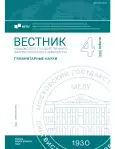The Pragmatics of Double Negation in the English Language
- Autores: Smurova O.V.1
-
Afiliações:
- Moscow State Linguistic University
- Edição: Nº 4(885) (2024)
- Páginas: 119-125
- Seção: Linguistics
- URL: https://bakhtiniada.ru/2542-2197/article/view/306529
- ID: 306529
Citar
Texto integral
Resumo
The article examines grammatical and ungrammatical types of double negation using examples of oral statements taken from BNC. It is shown that grammatical statements with double negation have pragmatic limitations, whereas non-normative statements with agreement on negativity have no such restrictions. A number of meanings depending on communicative and pragmatic conditions have been identified in statements containing the construction “not + adjective with a negative prefix”.
Sobre autores
Olga Smurova
Moscow State Linguistic University
Autor responsável pela correspondência
Email: olsmurova@yandex.ru
PhD (Philology), Assistant Professor at the Department of Grammar and History of the English Language, Faculty of the English language
RússiaBibliografia
- Leech, G. (2006). A glossary of English grammar. Edinburgh University Press.
- Blanchette, F. (2015). English negative concord, negative polarity, and double negation. New York: City University of New York.
- Zeijlstra, H. (2004). Sentential negation and negative concord. Amsterdam: University of Amsterdam.
- Hughes, A., Trudgill, P., Watt, D. (2013). English accents and dialects an introduction to social and regional varieties of British English. London and New York: Routledge.
- Coles-White, D’J. (2004). Negative Concord in Child African American English: Implications for Specific Language Impairment. Journal of Speech, Language, and Hearing Research, 47(1), 212–222.
- Grice, H. P. (1985) Logic and conversation. Novoe v zarubezhnoj lingvistike, 16, 217–237. (In Russ.)
- Wouden van der, Ton. (1996). Litotes and downward monotonicity. In H. Wansing (ed.), Negation: A Notion in Focus (pp. 145–167). Berlin: de Gruyter.
Arquivos suplementares










